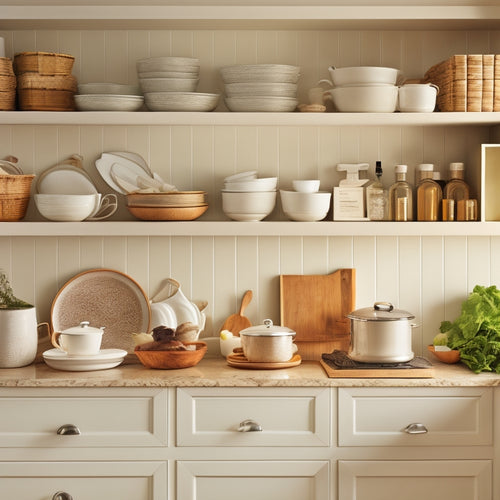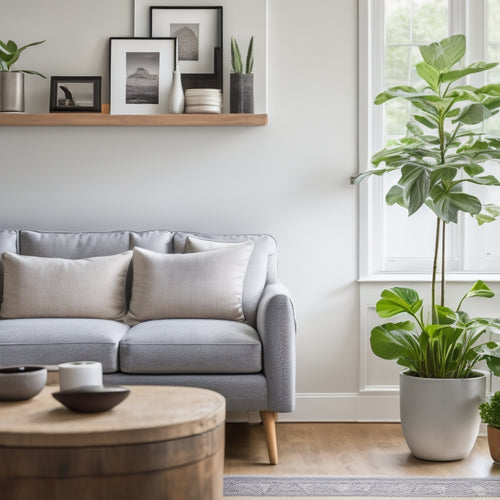
Efficient Toy Storage Solutions for Every Home
Share
Efficient toy storage solutions require a thoughtful and intentional approach that combines decluttering, categorization, and strategic organization to create a peaceful and functional living space. Begin by sorting toys into keep, donate, and discard piles, and then evaluate each toy's relevance, condition, and frequency of use. Implement a storage system that promotes tidiness and reduces stress, using multi-functional furniture, durable bins, and harmonious design. From under-bed rolling bins to creative shelving, explore the various solutions that cater to different areas of the home. As you explore these strategies, discover the perfect balance of functionality and style that suits your unique needs.
Key Takeaways
• Sort toys into categories to declutter and evaluate each item's relevance, condition, and frequency of use before storing.
• Design a functional storage system using multi-functional furniture, versatile shelving units, and durable bins for a harmonious living space.
• Utilize under-bed rolling bins for out-of-season items and implement closet organization for toys and clothes in the bedroom.
• Create a successful toy storage system that promotes tidiness and reduces stress by investing time in decluttering and organization.
• Incorporate creative shelving and clear storage bins for small items and accessories to maximize storage capacity and visual appeal.
Decluttering and Preparation Essentials
Before delving into toy storage solutions, what is the most pivotal step in setting up an effective and sustainable system? The answer lies in the decluttering and preparation process.
Sorting toys into categories, such as toys to keep, donate, and discard, is fundamental in determining what storage solutions are needed. The decluttering process involves evaluating each toy's relevance, condition, and frequency of use. By doing so, parents can identify which toys are worth keeping and which can be let go of, making the organization process more manageable.
A thorough decluttering process sets the stage for a successful toy storage system, ensuring that only what is necessary is stored, and making maintenance a breeze. By investing time in this critical step, parents can create a system that promotes tidiness, reduces stress, and encourages kids to take ownership of their belongings.
Living Room Storage Strategies
With a decluttered and curated collection of toys, attention can now be turned to designing a functional and aesthetically pleasing living room storage system that accommodates the needs of both kids and adults.
A creative display of toys can be achieved through the use of multi-functional furniture, such as a storage ottoman or a coffee table with built-in storage. The Ikea Kallax collection is a great option, offering sturdy and cost-effective shelving units that can be configured to fit your space.
Add durable bins, like Target's fabric bins, to store toys and keep them out of sight. This thoughtful design will create a harmonious living space where everyone can relax and enjoy quality time together.
Bedroom and Under-Bed Solutions
In the bedroom, a well-organized toy storage system can help maintain a sense of calm and tranquility, allowing kids to focus on sleep, reading, or quiet play. Effective storage solutions can also encourage kids to keep their space tidy, promoting a sense of responsibility and independence.
| Storage Solution | Description | Benefits |
|---|---|---|
| Under-bed rolling bins | Store out-of-season clothes, toys, or linens | Maximizes under-bed space, easy access |
| Bookshelves | Organize books, stuffed animals, and decorative items | Encourages reading, creative shelving options |
| Closet organization | Utilize shelves, bins, and hooks for toys and clothes | Customizable, promotes independence |
| Creative shelving | Incorporate floating shelves or ledge for display | Adds visual appeal, encourages creativity |
| Clear storage bins | Label and store small items like toys, accessories | Easy to identify contents, promotes organization |
Frequently Asked Questions
How Often Should I Rotate Toys to Keep Kids Interested and Engaged?
"Spark curiosity with a toy rotation frequency of every 4-6 weeks, ensuring a constant influx of novelty and variety that fosters engagement, while reaping the benefits of diversified play experiences that stimulate young minds."
What's the Ideal Age to Introduce Toy Categorization to Kids?
Introduce toy categorization around 18-24 months, when children begin to understand basic categorization concepts, under parental guidance, as this aligns with key developmental milestones, fostering cognitive and organizational skills.
Can I Repurpose Old Furniture for Toy Storage Solutions?
The eternal struggle of cluttered living spaces - but what if the solution lies in the very furniture we're tempted to discard? Repurposing old furniture through creative makeovers and upcycling can optimize space, sparking a revolutionary approach to toy storage and organization.
How Do I Ensure Kids Maintain Their Toy Organization Systems?
To guarantee kids maintain their toy organization systems, establish a reward system that acknowledges their efforts, and consistently reinforce good habits through parental involvement, providing ongoing guidance and support to encourage long-term responsibility and ownership.
Are Toy Storage Solutions Suitable for Children With Special Needs?
Like a puzzle, finding the right fit for children with special needs requires careful consideration. Toy storage solutions must address accessibility challenges with sensory-friendly options, offering customization possibilities while being mindful of budget considerations to guarantee inclusivity and independence.
Related Posts
-

Why Kitchen Cabinet Organization Matters Most
You're likely losing more than just time and ingredients when you can't find what you need in your kitchen cabinets -...
-

7 Essential Android Apps for a Clutter-Free Home
You're just a few taps away from transforming your cluttered space into a serene and organized oasis. Start by gamify...

